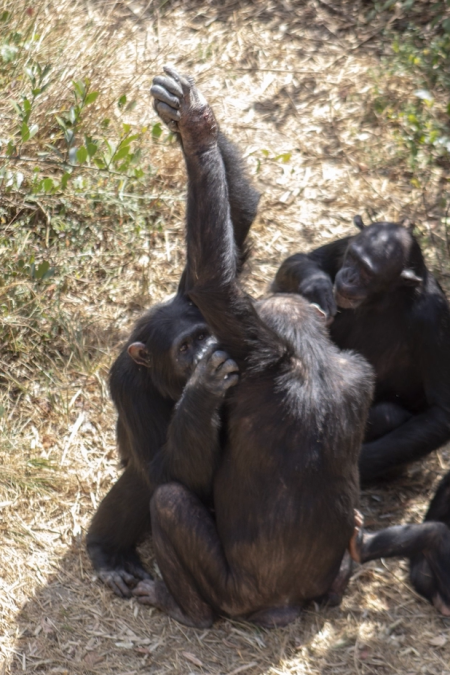High five: Chimpanzees communicate to coordinate grooming
Biologists provide first evidence of chimpanzees communicating about a cultural practice
Chimpanzees communicate with each other to coordinate a specific type of grooming. Biologists from Utrecht University noted this behaviour using extensive video observations, making it the first reported evidence that communication and cultural behaviour are closely intertwined in chimpanzees. The study also shows that cultural behaviour in animals can involve multiple individuals, and is not restricted to individual behaviour. The researchers published their results today in the journal Proceedings of the Royal Society B.

Some groups of chimpanzees groom each other in a specific way that is not observed in other groups. When two chimps start to groom this way, they both put one arm up in the air, grasping each other's hand, wrist or forearm. With the other arm, the animals groom other. Behavioural scientists have dubbed this way of joining hands the 'grooming handclasp'. Because only certain groups of chimpanzees exhibit this behaviour, which also occurs in slightly different varieties across these groups, researchers see this behaviour as a cultural custom.
Remote communication
Zoë Goldsborough and her colleagues discovered that chimpanzees living at a sanctuary in Zambia invite each other for grooming in this "traditional" way. Goldsborough: "Previous research showed that the grooming handclasp is initiated by one of the two chimps, by grabbing the arm of the other and pushing it up. But we found that the animals indicate, by means of communication, that this is the way they want to groom."
Tapping the elbow
This behaviour is clearly directed towards the other individual, says Goldsborough. A chimpanzee who wants to handclasp usually waits until it has grabbed the attention of its potential partner. Then it, for instance, raises an arm in the air.
"It's a bit like people raising their arm for a high five", says Goldsborough. Additionally, if the animals are already close together, they can briefly touch each other's elbows or hands to inform the other about their handclasp intentions.
Returning the favour
According to Edwin van Leeuwen, the senior researcher of the study, the chimpanzees in Zambia have been grooming this way for at least 20 years. "Why they groom this way is actually not known," says van Leeuwen. "Perhaps it's a way of making sure they will be returned the grooming favour. When the animals hold each other’s hand and look each other in the eye, they are completely focused on each other. This may increase the chance of being groomed in return, compared to a situation where one animal grooms the other one’s back, for instance."
Frame by frame
Goldsborough observed the chimpanzees as part of her master's degree at Utrecht University, spending five months in Zambia, filming the animals and then analysing the footage.
Our study shows that cultural behaviour can also occur between multiple conspecifics.
According to Goldsborough, that was quite a task. "First you have to start filming even before the chimpanzees display this behaviour, so you can really catch the actual start of their interaction. I spent entire days on the observation deck with a camera, sometimes even two. Usually I started filming as soon as two animals approached each other. After a while I got the hang of it, and I could tell by their looks when they were about to handclasp."
Goldsborough recorded over 130 grooming handclasps, and then analysed the footage frame by frame to see what animals were doing exactly. Goldsborough: "That was obviously a considerable effort."
Cultural life of animals
The results show that communication can also play an important role in the cultural lives of animals, and not just those of humans. Goldsborough: "Examples of cultural behaviour in animals are usually about what individuals do by themselves. A well-known example of this is chimpanzees using sticks to collect ants. Our study shows that cultural behaviour can also occur between multiple conspecifics. In this case, both animals have the motivation to do something. This fits nicely with a question that is now very much on the minds of researchers focusing on animal behaviour: how do animals coordinate their actions with each other?"
Publication
Chimpanzees communicate to coordinate a cultural practice
Proceedings of the Royal Society B, January 18, 2023. DOI: 10.1098/rspb.2022.1754
Zoë Goldsborough*, Anne Marijke Schel, Edwin J. C. van Leeuwen
*Goldsborough conducted this research for her master's degree at Utrecht University. She is currently affiliated with the Max Planck Institute of Animal Behaviour in Konstanz, Germany.

